The text of Hebrews
2023-10-26
The text of Hebrews
You have been learning about the Book of Hebrews or just To the Hebrews, which is its title in New Testament manuscripts:
Who wrote it
What it is about
Where it was sent
When it was written
Why it was written
and things like that.
So…
Who wrote it?
What is it about?
Where was it sent?
When was it written?
Why was it written?
Today’s topic
Today’s topic is, What did the author of Hebrews write?
It might surprise you that we need to ask this question although you have probably seen footnotes in your Bible saying Some manuscripts have…
Well, if some manuscripts have something else, which one is right? And does it make any difference? Hopefully you will have a better understanding of topics like this after today.
Copying exercise
To get started, I would like you all to make a copy of a piece of text. I will hand out the text and paper. The aim is for you to make your own copy without delay because you never know what can happen to interrupt the copying process. Please don’t use your phone to look up the text. Instead, wait till your neighbour has a copy then borrow theirs to make your own.
The text I’ve chosen is the first four verses of Hebrews in the King James Version. I’ve chosen that because its language is a bit archaic. You are free to make the language more comprehensible to modern readers but try not to change its meaning.
Heb 1.1-4 (AV)
God, who at sundry times and in divers manners spake in time past unto the fathers by the prophets, Hath in these last days spoken unto us by his Son, whom he hath appointed heir of all things, by whom also he made the worlds; Who being the brightness of his glory, and the express image of his person, and upholding all things by the word of his power, when he had by himself purged our sins, sat down on the right hand of the Majesty on high; Being made so much better than the angels, as he hath by inheritance obtained a more excellent name than they.
Copying in the olden days
At the start, copies were made onto papyrus using carbon-based ink, capital letters written without spaces between words, and little if any punctuation. Inks, writing media, lettering, and other details changed with time but copying was done by hand throughout. (Hand-copied is what manuscript means.) Mechanical printing wasn’t introduced to Europe until about 1450 and the first printed Greek New Testament wasn’t published until 1516. That means that the New Testament was copied by hand for about 1450 years. You could make your own copy – if you could read and write. Estimates vary, but the literacy rate for most of that 1450 years probably wasn’t more than 10%.
Papyrus

Young man with papyrus roll (1st century, Herculaneum)
Getting a copy
If you couldn’t make a copy yourself then you would have to get a scribe – either a volunteer (e.g. a reader in the early church) or a paid copyist (the going rate was a shirt or a couple of chickens a day). You also had to get a manuscript to copy the text from (what we call the exemplar). The aim was to make an accurate copy.
Scribes
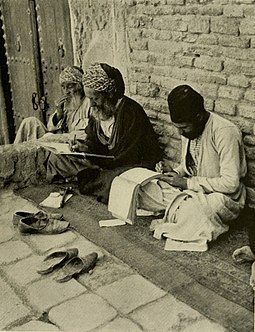
Jewish scribes at the Tomb of Ezekiel in Iraq (c. 1914)
Survival
Not all manuscripts survived. Some wore out, some were thrown away, some were buried, some were reused for other texts, some were confiscated, some were burnt. My guess is that the survival rate of pre-300 New Testament manuscripts is somewhere around one in a thousand.
Persecution
One cause of loss was intentional destruction of the scriptures. Numerous persecutions were directed against Christians at various locations within the Roman Empire in the first three hundred years of Christianity. The first Roman Emperor to target Christians was Nero (65 AD). Other bad persecutions happened under Emperors Marcus Aurelius (c. 180), Decius (c. 250), and Valerian (c. 255). The worst of all was under Diocletian (c. 303). It ended in 311 when Constantine and his co-rulers legalized Christianity. (Constantine’s mother was a Christian.)
Accounts of persecution
There are many accounts of the persecutions. Eusebius (c. 325) devotes large parts of his Church History (see e.g. section 8.2) to what happened. Another example is the Passion of the Scillitan Martyrs, which records what happened to a group of twelve North African Christians on July 17, 180 AD. One of the Christians on trial that day was carrying a copy of Paul’s Letters.
Some manuscripts of Hebrews
Here are some examples of manuscripts of Hebrews that have survived until today. (People often write MSS instead of manuscripts.) New Testament MSS are known by various names but all have been assigned standard identifiers (sigla) under the Gregory-Aland system. They are classified as papyri (e.g. P13, P46), uncials (e.g. 01, 02, 03, 04, 06), or minuscules (e.g. 1739, 2815) depending on what they were written on and whether written with majuscule (capital) or minuscule (cursive) letters. The date of a manuscript is usually estimated by handwriting style and therefore has wide error margins. Provenance (i.e. birthplace) is often little more than a guess.
P13

Part of P13 (c. 300, Egypt; black and white image)
P13 (continued)
P13 (Oxyrhynchus Papyrus 657) was dug up by Grenfell and Hunt at Oxyrhynchus, Egypt, around 1900. They dated it as first half of the fourth century. It is unusual for a Christian manuscript because it is written on a roll instead of a codex. (A codex is a book; Christians were the first group to adopt the codex for their texts.) P13 is copied onto the back of the New Epitome of Livy, which is a condensed history of Rome. (Does this say anything about who owned the manuscript?) There is a page number (MZ = 47) at the top. Can you recognise any of the text? (This page starts at Heb. 2.14.) I got to hold P13 once – it is mounted in glass and looks like a piece of cardboard with writing on it.
P46

P46 (c. 200, Egypt)
P46 (continued)
P46 is one of the Chester Beatty papyri. It was found somewhere in Egypt (possibly Fayyum) and was acquired by Alfred Chester Beatty around 1931. Starting in 1933, Frederic G. Kenyon published a series of books with descriptions, transcriptions (i.e. letter-for-letter reproductions), and colour facsimiles (i.e. pictures) of the manuscripts. P46 is a single quire codex. That is, whoever made it got one stack of sheets and folded them all in half to make a book. P46 contains nearly all of Paul’s Letters. You can see a page number (MA = 41), a line count for Romans (1000 lines), a title (To the Hebrews), a correction (by another scribe), and nomina sacra (i.e. sacred names written as abbreviations).
01 (Codex Sinaiticus)

Codex Sinaiticus (c. 350, Egypt?)
01 (continued)
Codex Sinaiticus is a pandect (a copy of the entire Bible) made around 350 AD. The picture doesn’t do it justice – better images are available at the Institute for New Testament Textual Research Virtual Manuscript Room. The manuscript is a work of art, with calligraphic writing. It would have cost about 200 animals their skins for the parchment alone. Constantin von Tischendorf took Sinaiticus from Saint Catherine’s Monastery in the Sinai and presented it to the Czar of Russia. Eventually it ended up in the British Museum. Tischendorf’s account of its discovery is a wonderful read. Theodore Skeat thought this codex might be one of the fifty Bibles made for Constantine by Eusebius.
02 (Codex Alexandrinus)

Codex Alexandrinus (c. 450, Egypt?)
02 (continued)
Codex Alexandrinus is another pandect. It is named after its suspected birthplace, Alexandria. It was taken from Alexandria to Constantinople by the remarkable Patriarch Cyril Lucaris, who presented it as a gift to the King of England in 1628. It has been in England ever since, now residing with Codex Sinaiticus in the British Museum. On its first page is a note written in Arabic: Bound to the Patriarchal Cell in the Fortress of Alexandria. Whoever removes it thence shall be excommunicated and cut off. Written by Athanasius the humble. (People used to chain books to the wall to stop them being stolen.)
03 (Vaticanus)

Codex Vaticanus (c. 350, Egypt or Palestine?)
03 (continued)
Codex Vaticanus is another pandect from about the same era as Sinaiticus. Theodore Skeat thought this also might be one of Constantine’s fifty Bibles. Modern editions of the Greek New Testament are strongly influenced by the text of Vaticanus. (Sinaiticus also carries a lot of weight.) You can see a scribal comment in the column next to a place where another scribe changed the more ancient text: ἀμαθέστατε καὶ κακέ, ἄφες τὸν παλαιόν, μὴ μεταποίει (Ignorant and bad! Leave the old reading! Do not change it!)
04 (Codex Ephraemi Rescriptus)

Codex Ephraimi Rescriptus (c. 450, Egypt?; black and white image)
04 (continued)
Codex Ephraemi Rescriptus is a palimpsest – a manuscript that has been reused for another text. You can see the text of Hebrews in majuscule letters, another text written in minuscule letters, and a lot of discolouration. The other text is a set of treatises by Saint Ephraim of Syria. Tischendorf spent years (1840-43) looking at the manuscript and managed to recover much of the Biblical text, against all expectations. (The discolouration is due to an earlier researcher who tried to bring out the faded writing by pouring potassium ferricyanide solution onto it.)
06 (Codex Claromontanus, Greek)

Codex Claromontanus (c. 550, Egypt?; Greek side)
06 (Codex Claromontanus, Latin)
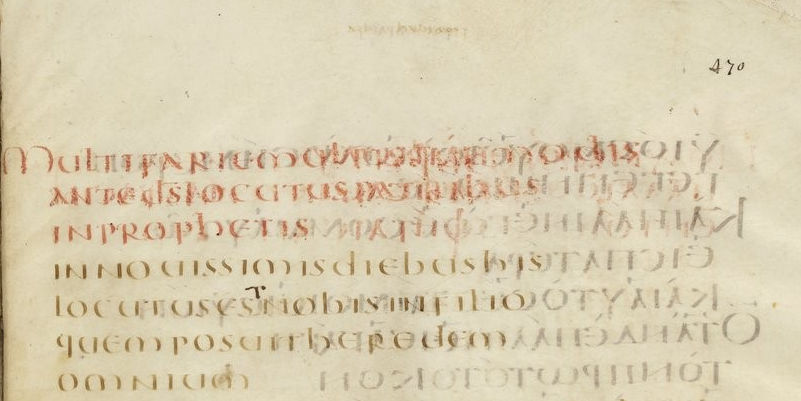
Codex Claromontanus (c. 550, Egypt?; Latin side)
06 (continued)
Codex Claromontanus is a Greek-Latin diglot (i.e. two language manuscript) with the Greek on the left-hand pages and the corresponding Latin on the right-hand ones. It contains Paul’s Letters. Images of the codex are available through the BNF (National Library of France) website. This is another beautiful manuscript, with rubrics (red lettering) at the beginning of books. The parchment is thin so reversed lettering from the other side of the page is visible. Page numbers are a late addition.
Minuscule 1739
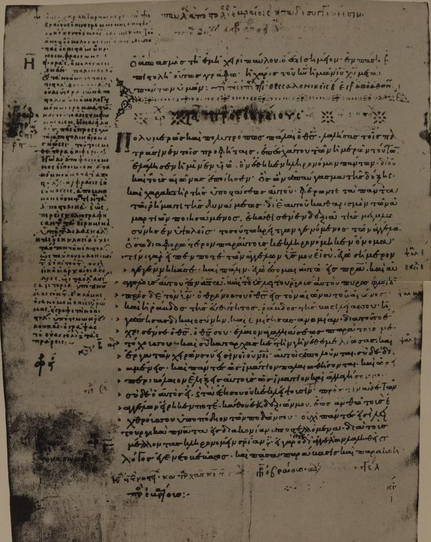
Minuscule 1739 (c. 950, Athos)
Minuscule 1739 (continued)
Minuscule 1739 is dated around 950 and is written in cursive script. Commentary by early church writers such as Irenaeus, Clement, Origen, Eusebius, and Basil (none later than 379 AD) is included in the borders surrounding the Bible text. This manuscript was copied by a scribe named Ephraim who lived on the Holy Mountain (Athos, Greece). According to Kirsopp Lake (Six Collations 1932, 144), there is a possibility that Ephraim … copied a critical edition of the New Testament which had been made in Caesarea from manuscripts and patristic writings preserved in the great library of Pamphilus.
Minuscule 2815

Minuscule 2815 (c. 1150, Basel)
Minuscule 2815 (continued)
Minuscule 2815 is one of the manuscripts that Erasmus used for his first edition of the Greek New Testament. Apologies for the poor quality image. This is what I used to transcribe the text for my Honours dissertation. The annotations are mine. Cursive Greek takes some getting used to. A fair bit of scribal shorthand needs to be deciphered in order to transcribe it. Gardthausen’s 1913 Griechische Palaeographie (vol. 2) helps a lot.
Erasmus
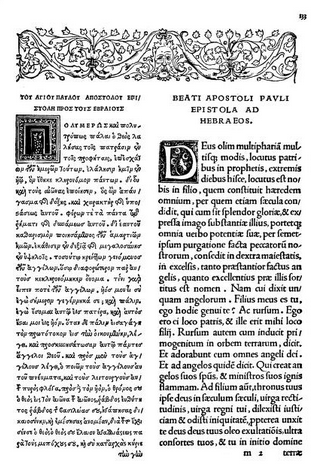
Greek New Testament (Erasmus, 1516)
Erasmus (continued)
To make his first edition, Erasmus grabbed manuscripts from a local library and gave them to a printer named Froben who used them as models for the Greek side of the edition. The Latin side is a fresh translation of the Greek by Erasmus (a revolutionary step). Many of the scribal features found in the manuscripts obtained by Erasmus were reproduced in the movable type used for printing. Erasmus said that his first edition was praecipitatum verius quam editum (that is, thrown together rather than edited). Nevertheless, it was instrumental in bringing about the Reformation. (Luther and Tyndale used Erasmus’ editions to produce their translations.)
My research
My first foray into New Testament textual research was an Honours dissertation that required transcription of the text of Hebrews for three manuscripts: P46, Codex Sinaiticus, and Minuscule 2815. (Transcription is transfer and mark up of text from page to computer.) Later, I did a PhD dissertation that required transcription of all the pre-1000 AD papyrus and uncial manuscripts of Hebrews (about 30 of them). I looked at facsimiles, microfilms, photos, and sometimes the manuscripts themselves in places like the National Library of Greece, the British Museum, and the Institute for New Testament Textual Research in Germany.
Analysis
Once the transcriptions were finished, I wrote computer programs to collate (i.e. compare) the texts word by word. Along the way I had been wondering how to visualize the relationships among the manuscript texts. A friend told me about software that biologists had developed to analyse relationships among species based on observational data (serendipity for which I thank God). I ended up using the software to perform multivariate analysis on distance matrices obtained from data matrices obtained from my collation programs.
How many variations?
Hebrews has about 5000 words. How many variations do you think there were among the 30 manuscripts compared? The answer is, about 2100. This led me to think, if a word can vary, it does vary if copied often enough. However, most of this variation is insignificant as far as meaning is concerned. Only about 300 of the 2100 are substantive variation (i.e. differences of meaning). The rest are orthographic variation comprised of spelling, accenting, and punctuation differences.
Substantive variations
Most of the 300 substantive variations don’t matter much (e.g. putting our Fathers instead of the Fathers). Some do make a difference that might be considered significant, such as apart from God versus by the grace of God at Heb 2.9. How does one decide which is the initial reading in such cases? There are about twelve guiding principles (e.g. which reading is most likely to have given rise to the others?) but none is guaranteed to work. Perhaps it is best to be aware of the variation and consider each possibility when pondering the text.
How accurate are today’s editions?
One thing I found out by transcribing all those manuscripts is that today’s editions (e.g. Nestle-Aland Novum Testamentum Graece, UBS Greek New Testament) are almost perfectly accurate. I did find one place where the editions were wrong – P46 has priest instead of high priest at Heb 7.28. It turned out that the people who make the editions (the INTF in Germany) had already discovered this. Current editions have this detail correct.
Multivariate analysis
One good thing about having all of the variation data is that you can use it to analyse relationships among the manuscript texts, making pictures that show family relationships. You can do the comparison using either substantive or orthographic variation. Here is an example of these two perspectives in analysis results for Hebrews.
Analysis result (substantive)
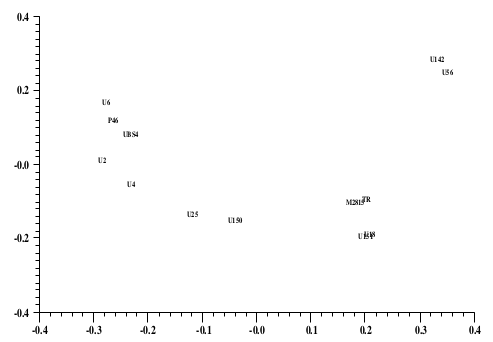
MVA result (04, substantive variation)
Analysis result (orthographic)
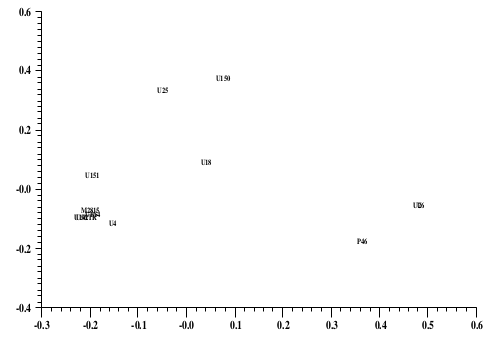
MVA result (04, orthographic variation)
Spelling indicates provenance?
For those interested, the analysis technique is called classical scaling and the axes are orthogonal directions of maximum variation. If you compare the two maps you will notice that most texts group in similar ways in both maps. Two exceptions are the UBS text and 04: both have texts like P46 but both spell like the edition produced by Erasmus (TR = Textus Receptus). If scribes spelled according to local conventions even when copying texts that differed from the local variety then multivariate analysis results obtained from orthographic variation data are a clue to manuscript provenance.
More data
The more data the better. My PhD only looked at papyrus and uncial manuscripts. A more complete picture emerges if we include more sources: papyri, uncials, minuscules, lectionaries, versions (i.e. ancient translations like Coptic, Syriac, Latin, Armenian, Georgian, Ethiopic), and patristic citations (i.e. quotations of the Bible text by early Christian writers such as Origen). If you put the substantive variation data for Hebrews found in the apparatus of the UBS Greek New Testament through the analysis mill then the following picture emerges. (See the UBS GNT for a key to the sigla.)
The big picture
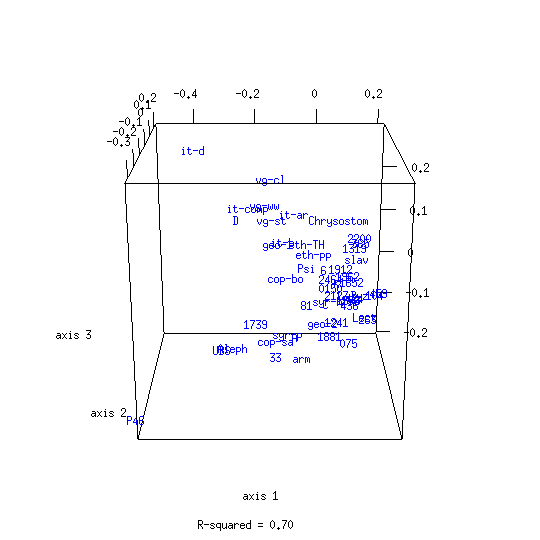
Analysis result (UBS GNT data, classical multidimensional scaling)
The big picture (continued)

Analysis result (UBS GNT data, neighbour joining)
Conclusion
The ancients liked to ask three questions:
What do you think?
Why do you think so?
What difference does it make?
Conclusion (continued)
After doing all this research, here is what I think. The New Testament text is authentic and reliable. Texts that are hand-copied exhibit textual variation. That is a mark of authenticity. The spelling distribution information is another mark of authenticity – it could not have been faked. Why do I think so? Because I took a deep dive into the topic and found that the sources are genuine and trustworthy. What difference does it make? Not much – I have no doubt that what we have today is substantially the same as what they wrote down way back then.
References
The Text of the New Testament by Kurt and Barbara Aland (2nd rev. ed., 1989) is a good introduction to the topic and includes a good rendition of the twelve guiding principles. Software and instructions on how to do multivariate analysis are available at my github code page. New Testament textual variation data to feed into the analysis chain is available by way of my github data page.
Postscript
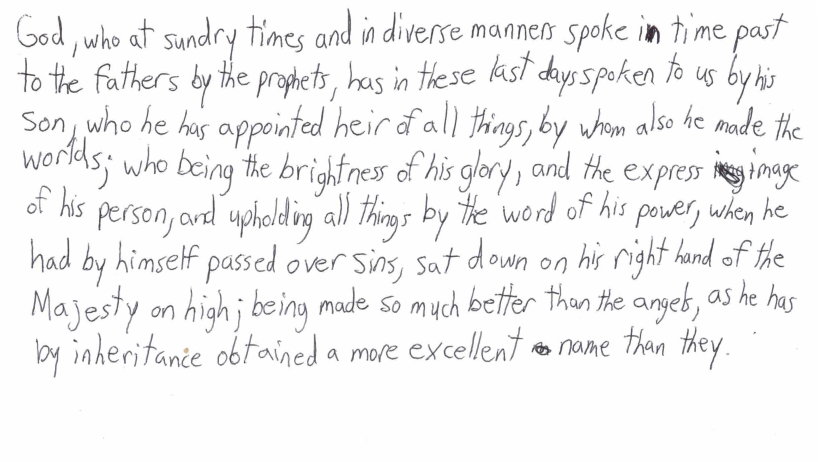
Result of the copying exercise
Postscript (continued)
The preceding slide shows the result of the copying exercise. Five people participated, each handing their copy on to be the exemplar for the next person to copy. They did pretty well, modernizing the archaic language. The spelling, punctuation, and capitalization were mainly preserved. However, a substantive variant was produced: passed over sins instead of purged our sins. This happened when someone turned purged into pursed, and the next copyist tried to make sense of the result. This confirms again that today’s university students are not capable of the accuracy attained by ancient copyists.